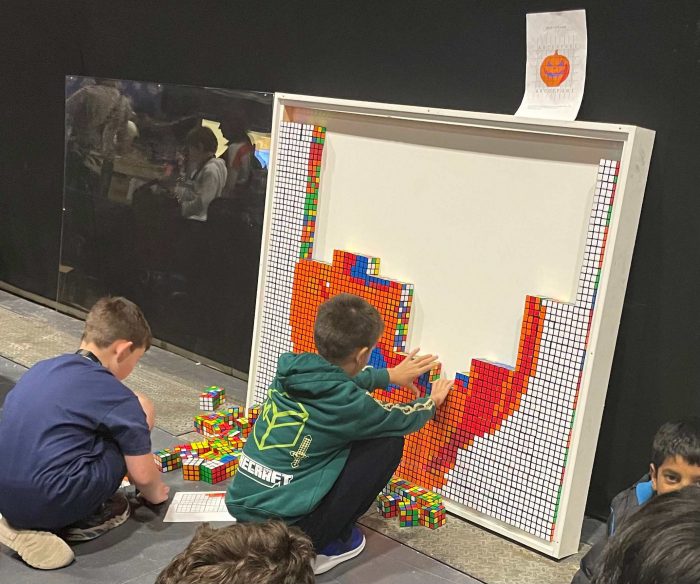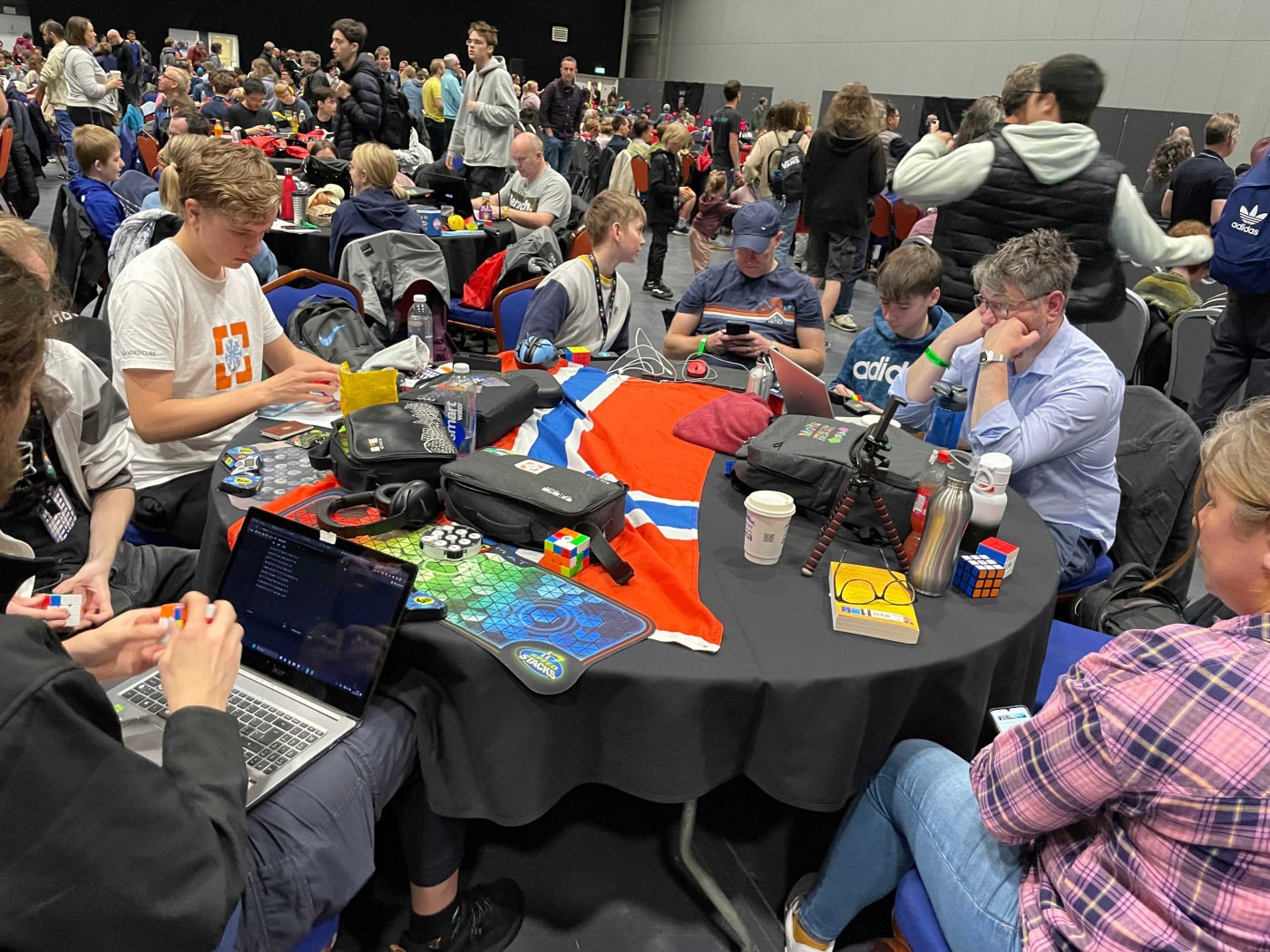Scrambled – inside the 2023 Rubik’s UK Championship
For lovers of the Rubik’s Cube, the greatest of all pursuits is ‘speedcubing’, the challenge to solve the square-shaped puzzle as quickly as possible. It’s a sport that attracts thousands of players from across the globe, competing in tournaments hosted by the World Cube Association, the WCA. The largest of these events nationally is the Rubik’s UK Championship, held this year in Coventry from 20-22 October. Reporting for The Boar, I sought to obtain a comprehensive picture of the sport of cubing: to look at who takes part, how it’s done, and above all, understand just what it is that makes turning the same cube for hours on end so exciting for the participants.
From the outset, I’m stunned by how busy the event actually is. There are over 500 competitors, most of them with an entourage of parents (the median age being probably somewhere around 14). I spent 45 minutes queuing to get inside. Standing amongst the waiting competitors, their heads bowed over cubes turning furiously in their hands, I get the impression of being surrounded by typewriters—such is the chorus of clacks from rotating cubes. Once eventually inside, I meet with Adam, an organiser for the event and Warwick alumnus. I note with bemusement that he too has a cube, which he turns without even looking as we talk.
The UK Championship, Adam tells me, has been going on since 2008. Its scale is international, with competitors from 25 different countries across three continents. Impressively, much of the administration of the tournament is crowdsourced – that is to say, most of the judges and many of the helpers are themselves competitors in the championship. With no set staff and 17 different categories, each for a different type of puzzle and nearly all taking place on the same stage, the potential for delays seems enormous, yet the tournament proceeds at breakneck pace. Even as I talk with Adam, a loudspeaker announces the end of the first round of the 3×3 solving – what Adam calls the main event of the Championship. The top 150 contestants have advanced to the next stage, all with times shorter than 13.12 seconds.
These contestants include Adam himself, who previously studied Mathematics at Warwick. Having been speedcubing competitively for six years now, this is his 48th competition. He has been a delegate, a competitor who helps run tournaments, for a year. Being so immersed in the world of speedcubing, he employs a slightly dizzying array of terms as he explains to me exactly how the championship functions. ‘Scrambling’ refers to the act of messing up the puzzles to be solved before each round, and this is done by hand by top volunteers. A computer generates a specific combination for every cube in the round to be matched to, so that no contestant gains a potential advantage—it means the scrambling is arguably harder than the solving.
almost every competitor will carry around a personal cube with them, which they seem to spin almost compulsively, allowing for a degree of latent practice.
Once scrambled, the puzzles (‘puzzle’ rather than cube, given that, I quickly learn, Rubik’s ‘Cubes’ come in every shape) are then brought out to the competitors’ tables, obscured by a box resembling a popcorn bucket. Once placed on the table, competitors are allowed a minute to prepare for the ‘solve’. The box is then removed, starting 15 seconds of ‘inspection time’ – it is during this time, I realise, that the best players actually solve the cube, rather than in the act of turning it as I had always assumed. By the time the 15 seconds have elapsed, the best players already know every move they will make, so can achieve solve times in the single digits. The timers for each solve are triggered by removing all eight fingertips from special mats and stopped by placing them down again. The scores are then recorded by the judges on personal cards and calculated to an average.
Now briefed by Adam, I am anxious to meet some of the competitors themselves, so I’m extremely fortunate to interview two international delegates, Carolina Guidetti of Italy and Delphine Tran of France. Both have been competing since 2017, and reckon they spend about 1-2 hours a day just solving cubes. But the real professionals, Tran says, will do it for a good 4-5 hours daily. As I’ve noticed by now, almost every competitor will carry around a personal cube with them, which they seem to spin almost compulsively, allowing for a degree of latent practice. “It’s like an addiction,” Guidetti adds, grinning.
there are more possible combinations of cube than there are grains of sand on Earth, and that therefore every scrambled cube is completely original.
What skills do they reckon are required for speedcubing? Guidetti thinks a good memory is key – the best cubers are the ones who can memorise and plan the furthest ahead. When competitive margins come down to the decimal point of seconds, pausing just once can wreck a record-attempt. Tran adds that simple speed is important too – knowing all the moves is useless if you can’t manoeuvre the cube fast enough.
By far the most exciting opportunity I get is an interview with a titan of the Rubik’s Cube world, George Scholey, 21. He is a veteran of over 50 Rubik’s Cube tournaments since he started in 2015, and first got into the sport via trying cube magic tricks. Once he starts a hobby, he explains, he tends to become extremely devoted to it. Nationally, he is now ranked fourth for best average solving time, and boasts two world records, for the most solved cubes on a skateboard and for the most solves in 24 hours. Scholey now works for the Rubik’s brand itself, for which he says he is extremely fortunate. Boasting a best time of 3.31 seconds, against the world record of 3.13 seconds, Scholey can rightfully claim to be one of the world’s best.
For someone who hasn’t solved a cube once, this is astounding. How does he do it, I ask him. Everything, he explains, is based on algorithms, and as he talks, he produces a cube from his jacket pocket and begins to twist it in his hands to demonstrate. Immediately, the colours are spinning like a slot machine; I feel my eyes glaze over. Scholey says that he memorises the algorithms necessary to solve different cube faces until it is like muscle memory. He compares it to learning chords on a piano – once you learn the different manoeuvres necessary for each problem you can solve them almost automatically. Of course, it takes thousands of hours of practice to get to this point. To stop himself getting bored, he explains, he remembers that there are more possible combinations of cube than there are grains of sand on Earth, and that therefore every scrambled cube is completely original. Every cube, he says excitedly, is as equally challenging as before.

Kids creating a mural out of Rubik’s Cubes | Image: Martin Day
Having spoken to these top players, the Head-to-Head Finals of the championship turn out to be far more exciting than I had anticipated. The top 16 competitors of the 3×3 category go up in pairs to race for the fastest average solving time. Each competitor mounts the stage to thumping bass music, reminding me of a wrestling match. Then suddenly there is dead silence, besides the quiet, incessant rattle of cubes from the audience. The biggest challenge of the final, I muse, is perhaps the atmosphere, as I watch sweat wiped off cubes with t-shirts by shaking hands. Every competitor here performs worse than in their previous round. As the psychodrama plays out, the judges do not announce the times, so as not to psyche out the competitors – but the audience more than makes up for this with their reactions; hushed gasps and rounds of applause seem to cause competitors to shrink into their chairs.
Ultimately, the top contestant is Twan Dullemond, with an astonishing 5.07 seconds as his best time. His runner-up is Mika Smulders, on 6.22 seconds. Both men are Dutch. Thankfully for national pride, this discredits them from actually winning the competition, so Nicholas Archer, with the third best time of 7.35, is duly crowned the UK speedcubing champion.
Afterwards, I wander over to a merchandise stand where the tournament’s sponsors have made a fortune selling puzzles. With the lessons of the championship echoing, I pick up a cube and study it apprehensively. Is it possible after all?
Beside me, a small boy picks up a puzzle shaped like a dodecahedron, and solves it in ten seconds. I stare at him, and then at the cube in my hand, and without another word let it clatter back onto the table.

Comments